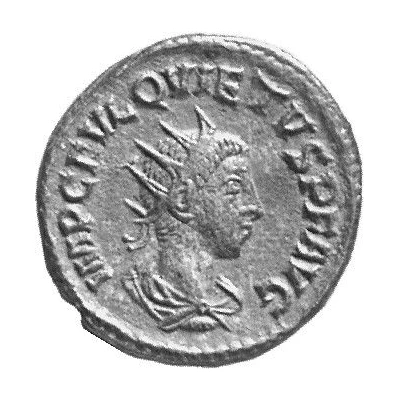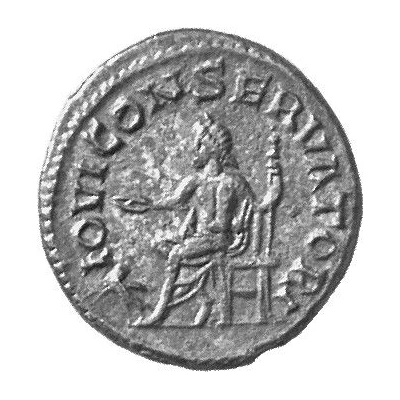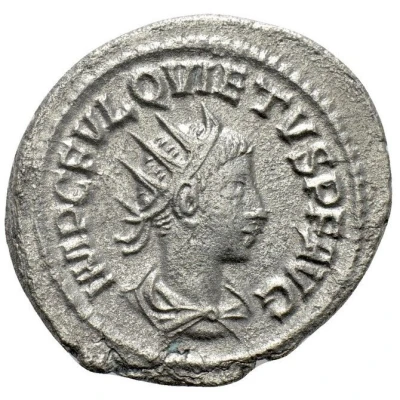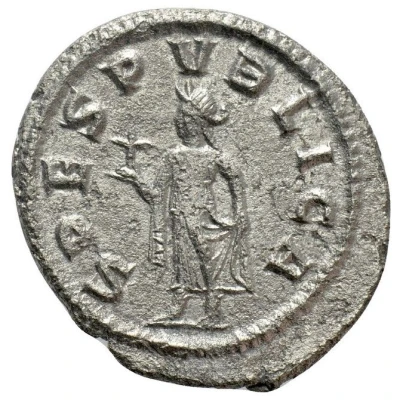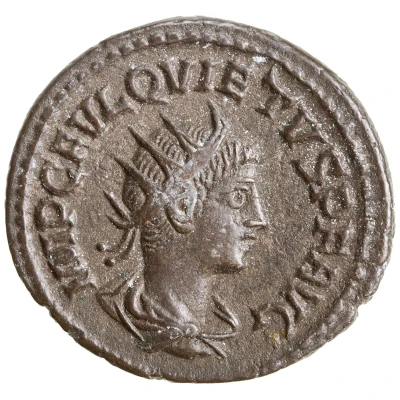
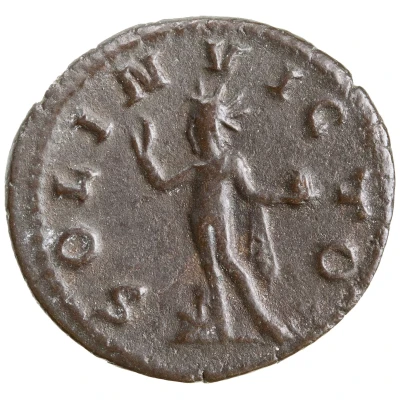

Antoninianus - Quietus SOLI INVICTO; Antioch
| Silver | 4 g | 20 mm |
| Issuer | Usurpations of Eastern provinces (Roman Imperial usurpations) |
|---|---|
| Ruling authority | Quietus (260-261) |
| Type | Standard circulation coin |
| Years | 260-261 |
| Composition | Silver |
| Weight | 4 g |
| Diameter | 20 mm |
| Shape | Round (irregular) |
| Technique | Hammered |
| Orientation | Coin alignment ↑↓ |
| Demonetized | Yes |
| Updated | 2024-10-10 |
| Numista | N#414001 |
|---|---|
| Rarity index | 100% |
Reverse
Sol, standing left, raising right hand and holding globe in left hand.
Script: Latin
Lettering: SOLI INVICTO
Comment
Further information
Quietus was the younger son of Fulvius Macrianus. Together with his brother Macrianus, he accepted the imperial title in 260 AD when the emperor Valerianus was captured by the Sasanians. While Macrianus moved to the western part of the empire to finally assert himself there, his brother Quietus remained in the east. In Illyria, Macrianus was defeated by the later usurper Aureolus in the autumn of 261 AD and fell in battle there together with his father; Quietus ultimately only held Emesa and was finally killed by the inhabitants. The city of Samosata was an important Roman military base in the Euphrates region. Following the construction of a dam, the ancient city has been lying at the bottom of a reservoir for a few years now.
Currency devaluation in the 3rd century AD
In the course of the third century AD, the increasing financial crisis of the Roman state also became dramatically evident in the money minted. Rising expenditure, particularly for the military, was offset by a dwindling supply of precious metals. Apart from the introduction of new money (i.e. a coinage reform), this problem could only be counteracted by the deterioration of coinage through a reduction in weight and fineness. Beginning with the period of the Severan dynasty (193-235 AD), but especially after around 253 AD, the silver content of denarii and double denarii fell dramatically, reaching a low of just 2% between the beginning of the sole rule of Gallienus in 260 and the reign of Aurelianus (270-275 AD). In the meantime, the aureus had also increasingly lost weight and lost its fixed link to the silver currency (25 denarii usually equalled one aureus). This devaluation of precious metal money went hand in hand with the decline of bronze coins; likewise, urban small change was discontinued in the east of the Roman Empire during this period. The first reforms by Aurelianus in 274 AD restored the fineness of the golden aureus, but the fixed conversion ratio in denarii was permanently abandoned; gold coins were now traded at the daily rate. Further attempts to establish a new silver currency were made under Diocletianus and later emperors. The Roman currency system was now used primarily for the payment of taxes and to finance the state administration and the military; it was increasingly based on a gold currency, while silver and silver coins only played a minor role.
The crisis of the 3rd century AD
With the end of the Severan imperial family (193-235 AD), numerous problems of the Roman Empire became apparent. Barbarian tribes threatened the border regions, and the army stationed there proclaimed individual commanders emperors in quick succession. The centre in Rome increasingly lost control over individual provinces: The era of the so-called soldier emperors had begun. This crisis-ridden situation became particularly apparent from the middle of the 3rd century AD. Valerianus I (reigned from 254) was the first Roman emperor to be imprisoned in 260 AD, while his son Gallienus had to contend with numerous usurpers and secessions. However, this period not only saw the peak of currency devaluation as a sign of the ongoing economic crisis, but also the first attempts at reforming the military, administration and finance by Gallienus and his successors. However, real success was not to be achieved until the extensive measures of Diocletianus (reigned 284-305 AD).
Interesting fact
One interesting fact about the Antoninianus - Quietus coin is that it features the image of a Roman emperor who ruled for a very short period of time. Quietus was a usurper who seized power in the Eastern provinces of the Roman Empire in 260-261 AD, but his reign was short-lived and he was eventually killed by his own soldiers. Despite his brief rule, coins bearing his image were still minted and circulated, making them a rare and interesting piece of Roman numismatic history.
